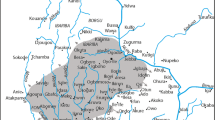Abstract
The COVID-19 pandemic is firing up our imagination about how to account for the past epidemics in archaeological contexts. This essay is a reflection on some of the historical cases of epidemic outbreaks in Yorùbá history, and what we can learn from social memory, oral traditions, and recent eyewitness accounts on how microbial attacks were managed in ancestral Yorùbá urban centers. Malignant microbes usually thrive in the kind of settlement configurations—dense towns and cities—that supported the preferred sociopolitical organization among the Yorùbá for over a millennium. Sacred groves were incorporated into the ancestral Yorùbá urban planning. They served many roles, including as isolation centers for managing epidemic outbreaks. Such isolation sites are difficult to identify in archaeological contexts without the aid of historical sources. However, contemplating how these special spaces were embedded in the past Yorùbá cultural lives could broaden our imagination of social regeneration processes in times of crisis (e.g., infectious disease). Résumé La pandémie COVID-19 stimule notre imagination sur la façon de rendre compte des épidémies passées dans des contextes archéologiques. Cet essai est une réflexion sur certains des cas historiques d'épidémies dans l'histoire de Yorùbá et sur ce que nous pouvons apprendre de la mémoire sociale, des traditions orales et des témoignages récents sur la manière dont les attaques microbiennes ont été gérées dans les centres urbains ancestraux de Yorùbá. Les microbes malins se développent généralement dans le type de configurations de peuplement - des villes denses - qui ont soutenu l'organisation sociopolitique préférée des Yorùbá pendant plus d'un millénaire. Les bois sacrés ont été intégrés dans l'urbanisme ancestral Yorùbá. Ils ont joué de nombreux rôles, notamment en tant que centres d'isolement pour gérer les flambées épidémiques. Ces sites d'isolement sont difficiles à identifier dans des contextes archéologiques sans l'aide de sources historiques. Cependant, envisager la façon dont ces espaces spéciaux ont été intégrés dans la vie culturelle passée des Yorùbá pourrait élargir notre imagination sur les processus de régénération sociale en temps de crise (par exemple, les maladies infectieuses).
Access this chapter
Tax calculation will be finalised at checkout
Purchases are for personal use only
Preview
Unable to display preview. Download preview PDF.
Similar content being viewed by others
Author information
Authors and Affiliations
Corresponding author
Editor information
Editors and Affiliations
Rights and permissions
Copyright information
© 2022 The Author(s), under exclusive license to Springer Nature Switzerland AG
About this chapter
Cite this chapter
Ogundiran, A. (2022). Managing Epidemics in Ancestral Yorùbá Towns and Cities: “Sacred Groves” as Isolation Sites. In: Sari, L., Mutri, G. (eds) Variability of Late Pleistocene and Holocene Microlithic Industries in Northern and Eastern Africa. Springer, Cham. https://doi.org/10.1007/978-3-031-18203-7_14
Download citation
DOI: https://doi.org/10.1007/978-3-031-18203-7_14
Published:
Publisher Name: Springer, Cham
Print ISBN: 978-3-031-18202-0
Online ISBN: 978-3-031-18203-7
eBook Packages: HistoryHistory (R0)



